java 代码
- 格式:doc
- 大小:5.44 KB
- 文档页数:1

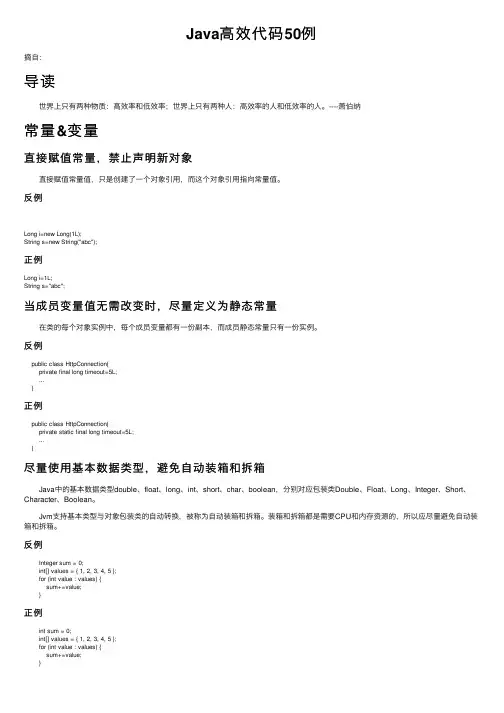
Java⾼效代码50例摘⾃:导读 世界上只有两种物质:⾼效率和低效率;世界上只有两种⼈:⾼效率的⼈和低效率的⼈。
----萧伯纳常量&变量直接赋值常量,禁⽌声明新对象 直接赋值常量值,只是创建了⼀个对象引⽤,⽽这个对象引⽤指向常量值。
反例Long i=new Long(1L);String s=new String("abc");正例Long i=1L;String s="abc";当成员变量值⽆需改变时,尽量定义为静态常量 在类的每个对象实例中,每个成员变量都有⼀份副本,⽽成员静态常量只有⼀份实例。
反例public class HttpConnection{private final long timeout=5L;...}正例public class HttpConnection{private static final long timeout=5L;...}尽量使⽤基本数据类型,避免⾃动装箱和拆箱 Java中的基本数据类型double、float、long、int、short、char、boolean,分别对应包装类Double、Float、Long、Integer、Short、Character、Boolean。
Jvm⽀持基本类型与对象包装类的⾃动转换,被称为⾃动装箱和拆箱。
装箱和拆箱都是需要CPU和内存资源的,所以应尽量避免⾃动装箱和拆箱。
反例Integer sum = 0;int[] values = { 1, 2, 3, 4, 5 };for (int value : values) {sum+=value;}正例int sum = 0;int[] values = { 1, 2, 3, 4, 5 };for (int value : values) {sum+=value;}如果变量的初值会被覆盖,就没有必要给变量赋初值反例public static void main(String[] args) {boolean isAll = false;List<Users> userList = new ArrayList<Users>();if (isAll) {userList = userDAO.queryAll();} else {userList=userDAO.queryActive();}}public class Users {}public static class userDAO {public static List<Users> queryAll() {return null;}public static List<Users> queryActive() {return null;}}正例public static void main(String[] args) {boolean isAll = false;List<Users> userList;if (isAll) {userList = userDAO.queryAll();} else {userList=userDAO.queryActive();}}public class Users {}public static class userDAO {public static List<Users> queryAll() {return null;}public static List<Users> queryActive() {return null;}}尽量使⽤函数内的基本类型临时变量 在函数内,基本类型的参数和临时变量都保存在栈(Stack)中,访问速度较快;对象类型的参数和临时变量的引⽤都保存在栈(Stack)中,内容都保存在堆(Heap)中,访问速度较慢。

Java代码动态编译1. 简介在Java开发中,编写好的代码需要经过编译才能运行。
通常情况下,我们会使用Java的编译器将代码转换成字节码,然后再由Java虚拟机(JVM)执行。
但有时候,我们可能需要在程序运行过程中动态地编译代码,即实现Java代码动态编译。
本文将详细介绍Java代码动态编译的概念、用途和实现方式。
2. 动态编译的概念动态编译是指在程序运行过程中,将一段字符串类型的Java代码转换成可执行的字节码,并且执行该字节码。
相比于传统的静态编译,动态编译允许我们在不修改源代码的情况下,根据特定的需求生成代码并执行。
3. 动态编译的用途动态编译在某些场景下非常有用。
下面列举了几种常见的用途:3.1 插件开发动态编译可以用于插件化开发。
我们可以允许用户在程序运行时加载、卸载和更新插件,而无需重启整个应用程序。
插件以字符串的形式传入,通过动态编译生成可执行的字节码,然后被加载和执行。
3.2 动态织入动态编译还可以用于AOP(面向切面编程)。
在AOP中,我们可以在运行时根据特定规则将切面代码织入到目标代码中,实现类似于日志记录、性能监控等功能。
3.3 脚本语言支持通过动态编译,Java程序可以支持解释脚本语言,比如JavaScript、Groovy等。
这样做的好处是,程序允许用户通过脚本语言编写部分逻辑,动态地加载和执行。
3.4 运行时代码生成有时候我们需要根据特定的需求生成代码,然后立即执行。
动态编译可以满足这一需求。
通过字符串拼接生成代码,然后动态编译执行,可以减少反射等运行时开销。
4. 动态编译的实现方式在Java中,动态编译的实现方式有多种,下面介绍两种常见的方式:4.1 使用Java Compiler APIJava Compiler API允许我们在程序运行时动态地将Java代码编译为字节码。
它提供了一个接口javax.tools.JavaCompiler,通过该接口我们可以获取到Java编译器,并使用它编译代码。
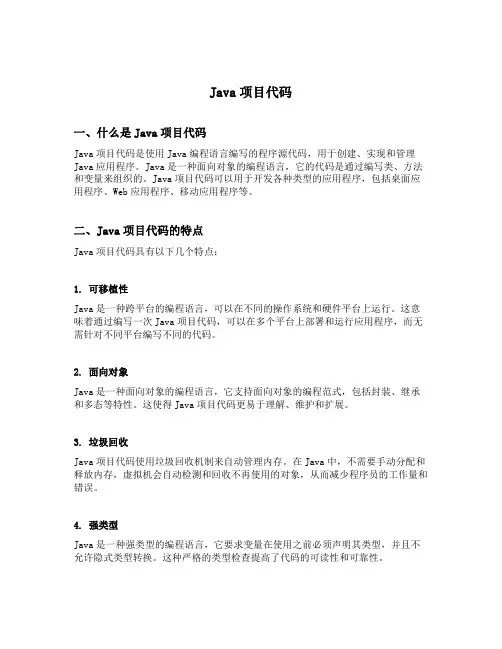
Java项目代码一、什么是Java项目代码Java项目代码是使用Java编程语言编写的程序源代码,用于创建、实现和管理Java应用程序。
Java是一种面向对象的编程语言,它的代码是通过编写类、方法和变量来组织的。
Java项目代码可以用于开发各种类型的应用程序,包括桌面应用程序、Web应用程序、移动应用程序等。
二、Java项目代码的特点Java项目代码具有以下几个特点:1. 可移植性Java是一种跨平台的编程语言,可以在不同的操作系统和硬件平台上运行。
这意味着通过编写一次Java项目代码,可以在多个平台上部署和运行应用程序,而无需针对不同平台编写不同的代码。
2. 面向对象Java是一种面向对象的编程语言,它支持面向对象的编程范式,包括封装、继承和多态等特性。
这使得Java项目代码更易于理解、维护和扩展。
3. 垃圾回收Java项目代码使用垃圾回收机制来自动管理内存。
在Java中,不需要手动分配和释放内存,虚拟机会自动检测和回收不再使用的对象,从而减少程序员的工作量和错误。
4. 强类型Java是一种强类型的编程语言,它要求变量在使用之前必须声明其类型,并且不允许隐式类型转换。
这种严格的类型检查提高了代码的可读性和可靠性。
5. 多线程支持Java项目代码可以利用Java提供的多线程机制实现并发处理。
多线程可以使应用程序同时执行多个任务,提高程序的运行效率和响应性。
三、如何编写Java项目代码要编写Java项目代码,需要遵循以下几个步骤:1. 确定项目需求在编写Java项目代码之前,需要明确项目的需求和目标。
这包括确定项目的功能和特性,以及所用到的技术和工具。
2. 设计项目架构在开始编写代码之前,需要进行项目架构的设计。
这包括确定项目的模块和组件,设计类的结构和关系,以及确定数据流和业务逻辑。
3. 编写代码根据项目的需求和架构设计,编写Java项目代码。
在编写代码时,需要遵循代码规范和最佳实践,使代码具有良好的可读性和可维护性。
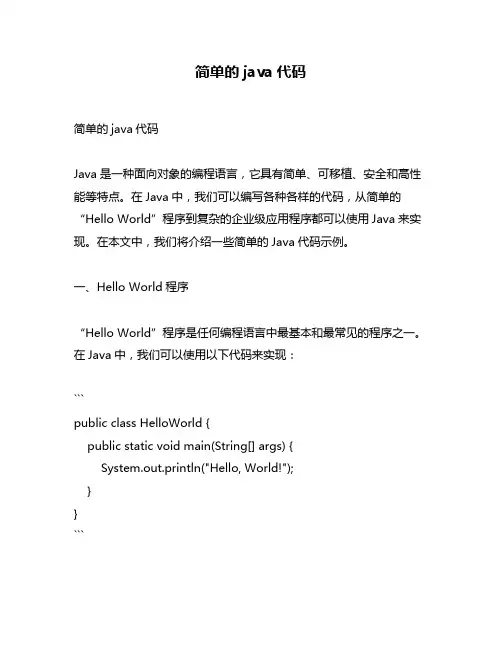
简单的java代码简单的java代码Java是一种面向对象的编程语言,它具有简单、可移植、安全和高性能等特点。
在Java中,我们可以编写各种各样的代码,从简单的“Hello World”程序到复杂的企业级应用程序都可以使用Java来实现。
在本文中,我们将介绍一些简单的Java代码示例。
一、Hello World程序“Hello World”程序是任何编程语言中最基本和最常见的程序之一。
在Java中,我们可以使用以下代码来实现:```public class HelloWorld {public static void main(String[] args) {System.out.println("Hello, World!");}}```这个程序很简单,它定义了一个名为“HelloWorld”的类,并在其中定义了一个名为“main”的方法。
该方法通过调用System.out.println()方法来输出“Hello, World!”字符串。
二、计算两个数之和下面是一个简单的Java程序,用于计算两个数之和:```import java.util.Scanner;public class AddTwoNumbers {public static void main(String[] args) {int num1, num2, sum;Scanner input = new Scanner(System.in);System.out.print("Enter first number: ");num1 = input.nextInt();System.out.print("Enter second number: ");num2 = input.nextInt();sum = num1 + num2;System.out.println("Sum of the two numbers is " + sum); }}该程序首先导入了java.util.Scanner类,以便从控制台读取输入。
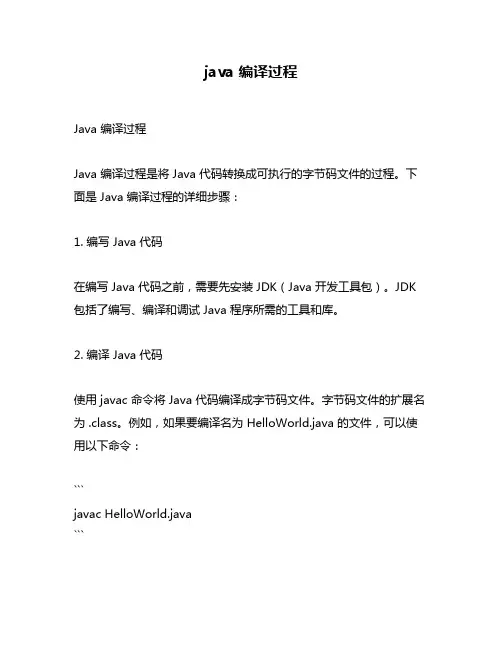
java 编译过程
Java 编译过程
Java 编译过程是将 Java 代码转换成可执行的字节码文件的过程。
下面是 Java 编译过程的详细步骤:
1. 编写 Java 代码
在编写 Java 代码之前,需要先安装 JDK(Java 开发工具包)。
JDK 包括了编写、编译和调试 Java 程序所需的工具和库。
2. 编译 Java 代码
使用 javac 命令将 Java 代码编译成字节码文件。
字节码文件的扩展名为 .class。
例如,如果要编译名为 HelloWorld.java 的文件,可以使用以下命令:
```
javac HelloWorld.java
```
3. 运行 Java 程序
使用 java 命令运行已经编译好的字节码文件。
例如,如果要运行HelloWorld.class 文件,可以使用以下命令:
```
java HelloWorld
```
4. 解释执行字节码文件
Java 虚拟机(JVM)会解释执行字节码文件,并将其转换成机器语言。
这样就可以在任何支持 JVM 的平台上运行相同的程序。
5. JIT 编译优化
JIT(Just-In-Time)编译器会对经常被执行的代码进行优化,以提高
程序的性能。
总结:
Java 编译过程包括编写、编译、运行、解释执行和 JIT 编译优化等步
骤。
通过这些步骤,Java 程序可以在不同的平台上运行,并且具有良好的性能表现。
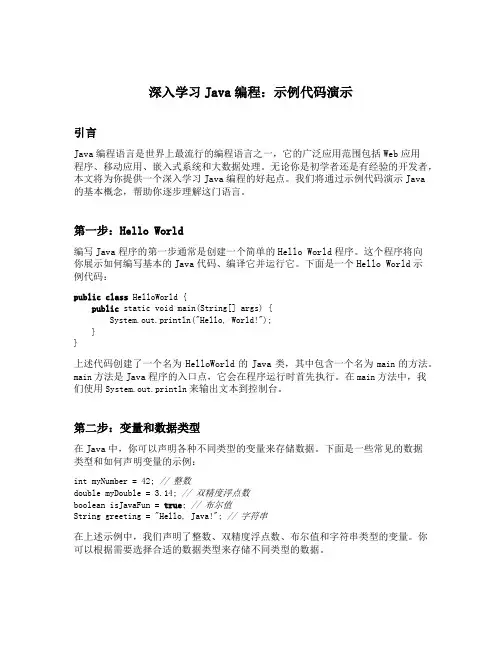
深入学习Java编程:示例代码演示引言Java编程语言是世界上最流行的编程语言之一,它的广泛应用范围包括Web应用程序、移动应用、嵌入式系统和大数据处理。
无论你是初学者还是有经验的开发者,本文将为你提供一个深入学习Java编程的好起点。
我们将通过示例代码演示Java的基本概念,帮助你逐步理解这门语言。
第一步:Hello World编写Java程序的第一步通常是创建一个简单的Hello World程序。
这个程序将向你展示如何编写基本的Java代码、编译它并运行它。
下面是一个Hello World示例代码:public class HelloWorld {public static void main(String[] args) {System.out.println("Hello, World!");}}上述代码创建了一个名为HelloWorld的Java类,其中包含一个名为main的方法。
main方法是Java程序的入口点,它会在程序运行时首先执行。
在main方法中,我们使用System.out.println来输出文本到控制台。
第二步:变量和数据类型在Java中,你可以声明各种不同类型的变量来存储数据。
下面是一些常见的数据类型和如何声明变量的示例:int myNumber = 42; // 整数double myDouble = 3.14; // 双精度浮点数boolean isJavaFun = true; // 布尔值String greeting = "Hello, Java!"; // 字符串在上述示例中,我们声明了整数、双精度浮点数、布尔值和字符串类型的变量。
你可以根据需要选择合适的数据类型来存储不同类型的数据。
第三步:条件语句和循环Java提供了条件语句和循环结构,允许你控制程序的流程和执行重复的操作。
以下是一些示例代码:条件语句(if-else)int age = 20;if (age >= 18) {System.out.println("你已经成年了");} else {System.out.println("你还未成年");}循环(for循环)for (int i = 1; i <= 5; i++) {System.out.println("循环迭代次数:" + i);}第四步:函数和方法在Java中,你可以创建自己的函数或方法,以便组织和重用代码。
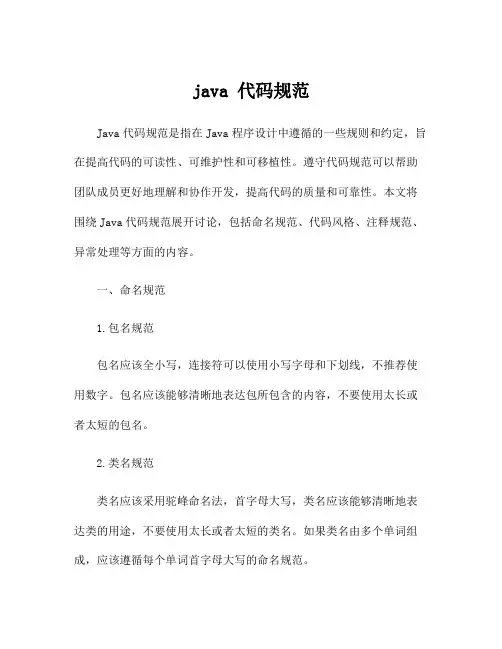
java 代码规范Java代码规范是指在Java程序设计中遵循的一些规则和约定,旨在提高代码的可读性、可维护性和可移植性。
遵守代码规范可以帮助团队成员更好地理解和协作开发,提高代码的质量和可靠性。
本文将围绕Java代码规范展开讨论,包括命名规范、代码风格、注释规范、异常处理等方面的内容。
一、命名规范1.包名规范包名应该全小写,连接符可以使用小写字母和下划线,不推荐使用数字。
包名应该能够清晰地表达包所包含的内容,不要使用太长或者太短的包名。
2.类名规范类名应该采用驼峰命名法,首字母大写,类名应该能够清晰地表达类的用途,不要使用太长或者太短的类名。
如果类名由多个单词组成,应该遵循每个单词首字母大写的命名规范。
3.接口名规范接口名应该采用驼峰命名法,首字母大写,接口名应该能够清晰地表达接口的用途,不要使用太长或者太短的接口名。
如果接口名由多个单词组成,应该遵循每个单词首字母大写的命名规范。
4.变量名规范变量名应该采用驼峰命名法,首字母小写,变量名应该能够清晰地表达变量的用途,不要使用太长或者太短的变量名。
如果变量名由多个单词组成,应该遵循每个单词首字母小写的命名规范。
5.常量名规范常量名应该全大写,单词之间使用下划线分隔,常量名应该能够清晰地表达常量的用途,不要使用太长或者太短的常量名。
6.方法名规范方法名应该采用驼峰命名法,首字母小写,方法名应该能够清晰地表达方法的用途,不要使用太长或者太短的方法名。
如果方法名由多个单词组成,应该遵循每个单词首字母小写的命名规范。
二、代码风格1.缩进和空格缩进使用4个空格,不使用tab键。
在操作符前后使用空格,增强代码的可读性。
2.大括号的使用在类定义、方法定义、控制结构等的语句块后面使用大括号,增强代码的可读性。
3.代码行长度每行代码的长度不要超过80个字符,超过80个字符的代码应该使用换行符进行分割。
4.引号的使用字符串常量应该使用双引号,字符常量应该使用单引号。
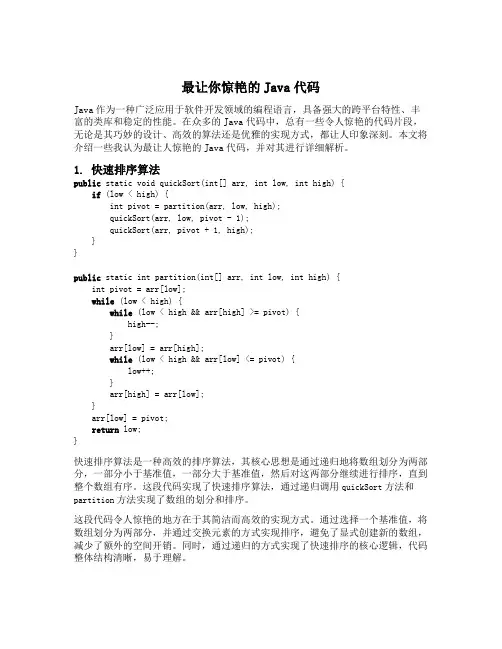
最让你惊艳的Java代码Java作为一种广泛应用于软件开发领域的编程语言,具备强大的跨平台特性、丰富的类库和稳定的性能。
在众多的Java代码中,总有一些令人惊艳的代码片段,无论是其巧妙的设计、高效的算法还是优雅的实现方式,都让人印象深刻。
本文将介绍一些我认为最让人惊艳的Java代码,并对其进行详细解析。
1. 快速排序算法public static void quickSort(int[] arr, int low, int high) {if (low < high) {int pivot = partition(arr, low, high);quickSort(arr, low, pivot - 1);quickSort(arr, pivot + 1, high);}}public static int partition(int[] arr, int low, int high) {int pivot = arr[low];while (low < high) {while (low < high && arr[high] >= pivot) {high--;}arr[low] = arr[high];while (low < high && arr[low] <= pivot) {low++;}arr[high] = arr[low];}arr[low] = pivot;return low;}快速排序算法是一种高效的排序算法,其核心思想是通过递归地将数组划分为两部分,一部分小于基准值,一部分大于基准值,然后对这两部分继续进行排序,直到整个数组有序。
这段代码实现了快速排序算法,通过递归调用quickSort方法和partition方法实现了数组的划分和排序。
这段代码令人惊艳的地方在于其简洁而高效的实现方式。
通过选择一个基准值,将数组划分为两部分,并通过交换元素的方式实现排序,避免了显式创建新的数组,减少了额外的空间开销。

Java中常⽤的代码汇总1. 字符串有整型的相互转换String a = String.valueOf(2); //integer to numeric stringint i = Integer.parseInt(a); //numeric string to an int2. 向⽂件末尾添加内容BufferedWriter out = null;try {out = new BufferedWriter(new FileWriter(”filename”, true));out.write(”aString”);} catch (IOException e) {// error processing code} finally {if (out != null) {out.close();}}3. 得到当前⽅法的名字String methodName = Thread.currentThread().getStackTrace()[1].getMethodName();4. 转字符串到⽇期java.util.Date = java.text.DateFormat.getDateInstance().parse(date String);或者是:SimpleDateFormat format = new SimpleDateFormat( "dd.MM.yyyy" );Date date = format.parse( myString );5. 使⽤JDBC链接Oraclepublic class OracleJdbcTest{String driverClass = "oracle.jdbc.driver.OracleDriver";Connection con;public void init(FileInputStream fs) throws ClassNotFoundException, SQLException, FileNotFoundException, IOException {Properties props = new Properties();props.load(fs);String url = props.getProperty("db.url");String userName = props.getProperty("er");String password = props.getProperty("db.password");Class.forName(driverClass);con=DriverManager.getConnection(url, userName, password);}public void fetch() throws SQLException, IOException{PreparedStatement ps = con.prepareStatement("select SYSDATE from dual");ResultSet rs = ps.executeQuery();while (rs.next()){// do the thing you do}rs.close();ps.close();}public static void main(String[] args){OracleJdbcTest test = new OracleJdbcTest();test.init();test.fetch();}}6. 把 Java util.Date 转成 sql.Datejava.util.Date utilDate = new java.util.Date();java.sql.Date sqlDate = new java.sql.Date(utilDate.getTime());7. 使⽤NIO进⾏快速的⽂件拷贝public static void fileCopy( File in, File out )throws IOException{FileChannel inChannel = new FileInputStream( in ).getChannel();FileChannel outChannel = new FileOutputStream( out ).getChannel();try{// inChannel.transferTo(0, inChannel.size(), outChannel); // original -- apparently has trouble copying large files on Windows // magic number for Windows, 64Mb - 32Kb)int maxCount = (64 * 1024 * 1024) - (32 * 1024);long size = inChannel.size();long position = 0;while ( position < size ){position += inChannel.transferTo( position, maxCount, outChannel );}}finally{if ( inChannel != null ){inChannel.close();}if ( outChannel != null ){outChannel.close();}}}8. 创建图⽚的缩略图private void createThumbnail(String filename, int thumbWidth, int thumbHeight, int quality, String outFilename)throws InterruptedException, FileNotFoundException, IOException{// load image from filenameImage image = Toolkit.getDefaultToolkit().getImage(filename);MediaTracker mediaTracker = new MediaTracker(new Container());mediaTracker.addImage(image, 0);mediaTracker.waitForID(0);// use this to test for errors at this point: System.out.println(mediaTracker.isErrorAny());// determine thumbnail size from WIDTH and HEIGHTdouble thumbRatio = (double)thumbWidth / (double)thumbHeight;int imageWidth = image.getWidth(null);int imageHeight = image.getHeight(null);double imageRatio = (double)imageWidth / (double)imageHeight;if (thumbRatio < imageRatio) {thumbHeight = (int)(thumbWidth / imageRatio);} else {thumbWidth = (int)(thumbHeight * imageRatio);}// draw original image to thumbnail image object and// scale it to the new size on-the-flyBufferedImage thumbImage = new BufferedImage(thumbWidth, thumbHeight, BufferedImage.TYPE_INT_RGB);Graphics2D graphics2D = thumbImage.createGraphics();graphics2D.setRenderingHint(RenderingHints.KEY_INTERPOLATION, RenderingHints.VALUE_INTERPOLATION_BILINEAR); graphics2D.drawImage(image, 0, 0, thumbWidth, thumbHeight, null);// save thumbnail image to outFilenameBufferedOutputStream out = new BufferedOutputStream(new FileOutputStream(outFilename));JPEGImageEncoder encoder = JPEGCodec.createJPEGEncoder(out);JPEGEncodeParam param = encoder.getDefaultJPEGEncodeParam(thumbImage);quality = Math.max(0, Math.min(quality, 100));param.setQuality((float)quality / 100.0f, false);encoder.setJPEGEncodeParam(param);encoder.encode(thumbImage);out.close();}9.创建 JSON 格式的数据import org.json.JSONObject;......JSONObject json = new JSONObject();json.put("city", "Mumbai");json.put("country", "India");...String output = json.toString();...10. 使⽤iText JAR⽣成PDFimport java.io.File;import java.io.FileOutputStream;import java.io.OutputStream;import java.util.Date;import com.lowagie.text.Document;import com.lowagie.text.Paragraph;import com.lowagie.text.pdf.PdfWriter;public class GeneratePDF {public static void main(String[] args) {try {OutputStream file = new FileOutputStream(new File("C:\\Test.pdf")); Document document = new Document();PdfWriter.getInstance(document, file);document.open();document.add(new Paragraph("Hello Kiran"));document.add(new Paragraph(new Date().toString()));document.close();file.close();} catch (Exception e) {e.printStackTrace();}}}11. HTTP 代理设置System.getProperties().put("http.proxyHost", "someProxyURL"); System.getProperties().put("http.proxyPort", "someProxyPort"); System.getProperties().put("http.proxyUser", "someUserName"); System.getProperties().put("http.proxyPassword", "somePassword"); 12. 单实例Singleton ⽰例public class SimpleSingleton {private static SimpleSingleton singleInstance = new SimpleSingleton(); //Marking default constructor private//to avoid direct instantiation.private SimpleSingleton() {}//Get instance for class SimpleSingletonpublic static SimpleSingleton getInstance() {return singleInstance;}}13. 抓屏程序import java.awt.Dimension;import java.awt.Rectangle;import java.awt.Robot;import java.awt.Toolkit;import java.awt.image.BufferedImage;import javax.imageio.ImageIO;import java.io.File;...public void captureScreen(String fileName) throws Exception {Dimension screenSize = Toolkit.getDefaultToolkit().getScreenSize(); Rectangle screenRectangle = new Rectangle(screenSize);Robot robot = new Robot();BufferedImage image = robot.createScreenCapture(screenRectangle); ImageIO.write(image, "png", new File(fileName));}...14. 列出⽂件和⽬录File dir = new File("directoryName");String[] children = dir.list();if (children == null) {// Either dir does not exist or is not a directory} else {for (int i=0; i < children.length; i++) {// Get filename of file or directoryString filename = children[i];}}// It is also possible to filter the list of returned files.// This example does not return any files that start with `.'.FilenameFilter filter = new FilenameFilter() {public boolean accept(File dir, String name) {return !name.startsWith(".");}};children = dir.list(filter);// The list of files can also be retrieved as File objectsFile[] files = dir.listFiles();// This filter only returns directoriesFileFilter fileFilter = new FileFilter() {public boolean accept(File file) {return file.isDirectory();}};files = dir.listFiles(fileFilter);15. 创建ZIP和JAR⽂件import java.util.zip.*;import java.io.*;public class ZipIt {public static void main(String args[]) throws IOException {if (args.length < 2) {System.err.println("usage: java ZipIt Zip.zip file1 file2 file3");System.exit(-1);}File zipFile = new File(args[0]);if (zipFile.exists()) {System.err.println("Zip file already exists, please try another");System.exit(-2);}FileOutputStream fos = new FileOutputStream(zipFile);ZipOutputStream zos = new ZipOutputStream(fos);int bytesRead;byte[] buffer = new byte[1024];CRC32 crc = new CRC32();for (int i=1, n=args.length; i < n; i++) {String name = args[i];File file = new File(name);if (!file.exists()) {System.err.println("Skipping: " + name);continue;}BufferedInputStream bis = new BufferedInputStream(new FileInputStream(file));crc.reset();while ((bytesRead = bis.read(buffer)) != -1) {crc.update(buffer, 0, bytesRead);}bis.close();// Reset to beginning of input streambis = new BufferedInputStream(new FileInputStream(file));ZipEntry entry = new ZipEntry(name);entry.setMethod(ZipEntry.STORED);entry.setCompressedSize(file.length());entry.setSize(file.length());entry.setCrc(crc.getValue());zos.putNextEntry(entry);while ((bytesRead = bis.read(buffer)) != -1) {zos.write(buffer, 0, bytesRead);}bis.close();}zos.close();}}16. 解析/读取XML ⽂件XML⽂件<?xml version="1.0"?><students><student><name>John</name><grade>B</grade><age>12</age></student><student><name>Mary</name><grade>A</grade><age>11</age></student><student><name>Simon</name><grade>A</grade><age>18</age></student></students>Java代码<span style="font-family:Arial;font-size:14px;">package net.viralpatel.java.xmlparser; import java.io.File;import javax.xml.parsers.DocumentBuilder;import javax.xml.parsers.DocumentBuilderFactory;import org.w3c.dom.Document;import org.w3c.dom.Element;import org.w3c.dom.Node;import org.w3c.dom.NodeList;public class XMLParser {public void getAllUserNames(String fileName) {try {DocumentBuilderFactory dbf = DocumentBuilderFactory.newInstance();DocumentBuilder db = dbf.newDocumentBuilder();File file = new File(fileName);if (file.exists()) {Document doc = db.parse(file);Element docEle = doc.getDocumentElement();// Print root element of the documentSystem.out.println("Root element of the document: "+ docEle.getNodeName());NodeList studentList = docEle.getElementsByTagName("student");// Print total student elements in documentSystem.out.println("Total students: " + studentList.getLength());if (studentList != null && studentList.getLength() > 0) {for (int i = 0; i < studentList.getLength(); i++) {Node node = studentList.item(i);if (node.getNodeType() == Node.ELEMENT_NODE) {System.out.println("=====================");Element e = (Element) node;NodeList nodeList = e.getElementsByTagName("name");System.out.println("Name: "+ nodeList.item(0).getChildNodes().item(0).getNodeValue());nodeList = e.getElementsByTagName("grade");System.out.println("Grade: "+ nodeList.item(0).getChildNodes().item(0).getNodeValue());nodeList = e.getElementsByTagName("age");System.out.println("Age: "+ nodeList.item(0).getChildNodes().item(0).getNodeValue());}}} else {System.exit(1);}}} catch (Exception e) {System.out.println(e);}}public static void main(String[] args) {XMLParser parser = new XMLParser();parser.getAllUserNames("c:\\test.xml");}}17. 把 Array 转换成 Mapimport java.util.Map;import ng.ArrayUtils;public class Main {public static void main(String[] args) {String[][] countries = { { "United States", "New York" }, { "United Kingdom", "London" }, { "Netherland", "Amsterdam" }, { "Japan", "Tokyo" }, { "France", "Paris" } };Map countryCapitals = ArrayUtils.toMap(countries);System.out.println("Capital of Japan is " + countryCapitals.get("Japan"));System.out.println("Capital of France is " + countryCapitals.get("France"));}}18. 发送邮件import javax.mail.*;import javax.mail.internet.*;import java.util.*;public void postMail( String recipients[ ], String subject, String message , String from) throws MessagingException {boolean debug = false;//Set the host smtp addressProperties props = new Properties();props.put("mail.smtp.host", "");// create some properties and get the default SessionSession session = Session.getDefaultInstance(props, null);session.setDebug(debug);// create a messageMessage msg = new MimeMessage(session);// set the from and to addressInternetAddress addressFrom = new InternetAddress(from);msg.setFrom(addressFrom);InternetAddress[] addressTo = new InternetAddress[recipients.length];for (int i = 0; i < recipients.length; i++){addressTo[i] = new InternetAddress(recipients[i]);}msg.setRecipients(Message.RecipientType.TO, addressTo);// Optional : You can also set your custom headers in the Email if you Wantmsg.addHeader("MyHeaderName", "myHeaderValue");// Setting the Subject and Content Typemsg.setSubject(subject);msg.setContent(message, "text/plain");Transport.send(msg);}19. 发送代数据的HTTP 请求import java.io.BufferedReader;import java.io.InputStreamReader;import .URL;public class Main {public static void main(String[] args) {try {URL my_url = new URL("/");BufferedReader br = new BufferedReader(new InputStreamReader(my_url.openStream()));String strTemp = "";while(null != (strTemp = br.readLine())){System.out.println(strTemp);}} catch (Exception ex) {ex.printStackTrace();}}}20. 改变数组的⼤⼩/*** Reallocates an array with a new size, and copies the contents* of the old array to the new array.* @param oldArray the old array, to be reallocated.* @param newSize the new array size.* @return A new array with the same contents.*/private static Object resizeArray (Object oldArray, int newSize) {int oldSize = ng.reflect.Array.getLength(oldArray);Class elementType = oldArray.getClass().getComponentType();Object newArray = ng.reflect.Array.newInstance(elementType,newSize);int preserveLength = Math.min(oldSize,newSize);if (preserveLength > 0)System.arraycopy (oldArray,0,newArray,0,preserveLength);return newArray;}// Test routine for resizeArray().public static void main (String[] args) {int[] a = {1,2,3};a = (int[])resizeArray(a,5);a[3] = 4;a[4] = 5;for (int i=0; i<a.length; i++)System.out.println (a[i]);}以上所述就是本⽂的全部内容了,希望⼤家能够喜欢。
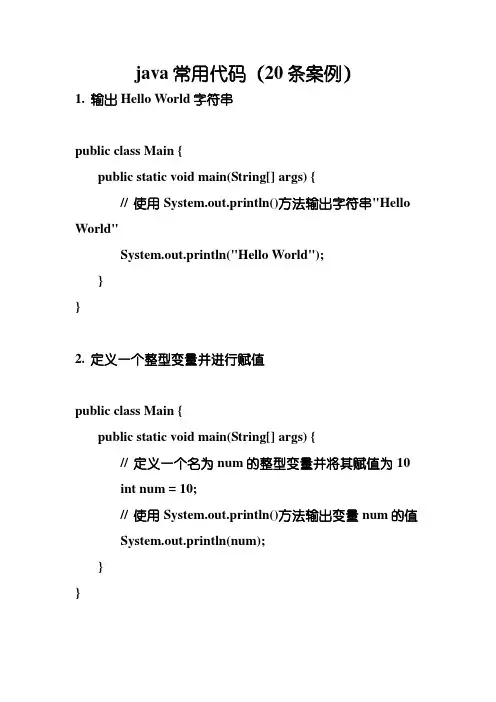
java常用代码(20条案例)1. 输出Hello World字符串public class Main {public static void main(String[] args) {// 使用System.out.println()方法输出字符串"Hello World"System.out.println("Hello World");}}2. 定义一个整型变量并进行赋值public class Main {public static void main(String[] args) {// 定义一个名为num的整型变量并将其赋值为10int num = 10;// 使用System.out.println()方法输出变量num的值System.out.println(num);}}3. 循环打印数字1到10public class Main {public static void main(String[] args) {// 使用for循环遍历数字1到10for (int i = 1; i <= 10; i++) {// 使用System.out.println()方法输出每个数字System.out.println(i);}}}4. 实现输入输出import java.util.Scanner;public class Main {public static void main(String[] args) {// 创建一个Scanner对象scanner,以便接受用户的输入Scanner scanner = new Scanner(System.in);// 使用scanner.nextLine()方法获取用户输入的字符串String input = scanner.nextLine();// 使用System.out.println()方法输出输入的内容System.out.println("输入的是:" + input);}}5. 实现条件分支public class Main {public static void main(String[] args) {// 定义一个整型变量num并将其赋值为10int num = 10;// 使用if语句判断num是否大于0,如果是,则输出"这个数是正数",否则输出"这个数是负数"if (num > 0) {System.out.println("这个数是正数");} else {System.out.println("这个数是负数");}}}6. 使用数组存储数据public class Main {public static void main(String[] args) {// 定义一个整型数组nums,其中包含数字1到5int[] nums = new int[]{1, 2, 3, 4, 5};// 使用for循环遍历数组for (int i = 0; i < nums.length; i++) {// 使用System.out.println()方法输出每个数组元素的值System.out.println(nums[i]);}}}7. 打印字符串长度public class Main {public static void main(String[] args) {// 定义一个字符串变量str并将其赋值为"HelloWorld"String str = "Hello World";// 使用str.length()方法获取字符串的长度,并使用System.out.println()方法输出长度System.out.println(str.length());}}8. 字符串拼接public class Main {public static void main(String[] args) {// 定义两个字符串变量str1和str2,并分别赋值为"Hello"和"World"String str1 = "Hello";String str2 = "World";// 使用"+"号将两个字符串拼接成一个新字符串,并使用System.out.println()方法输出拼接后的结果System.out.println(str1 + " " + str2);}}9. 使用方法进行多次调用public class Main {public static void main(String[] args) {// 定义一个名为str的字符串变量并将其赋值为"Hello World"String str = "Hello World";// 调用printStr()方法,打印字符串变量str的值printStr(str);// 调用add()方法,计算两个整数的和并输出结果int result = add(1, 2);System.out.println(result);}// 定义一个静态方法printStr,用于打印字符串public static void printStr(String str) {System.out.println(str);}// 定义一个静态方法add,用于计算两个整数的和public static int add(int a, int b) {return a + b;}}10. 使用继承实现多态public class Main {public static void main(String[] args) {// 创建一个Animal对象animal,并调用move()方法Animal animal = new Animal();animal.move();// 创建一个Dog对象dog,并调用move()方法Dog dog = new Dog();dog.move();// 创建一个Animal对象animal2,但其实际指向一个Dog对象,同样调用move()方法Animal animal2 = new Dog();animal2.move();}}// 定义一个Animal类class Animal {public void move() {System.out.println("动物在移动");}}// 定义一个Dog类,继承自Animal,并重写了move()方法class Dog extends Animal {public void move() {System.out.println("狗在奔跑");}}11. 输入多个数并求和import java.util.Scanner;public class Main {public static void main(String[] args) {// 创建一个Scanner对象scanner,以便接受用户的输入Scanner scanner = new Scanner(System.in);// 定义一个整型变量sum并将其赋值为0int sum = 0;// 使用while循环持续获取用户输入的整数并计算总和,直到用户输入为0时结束循环while (true) {System.out.println("请输入一个整数(输入0退出):");int num = scanner.nextInt();if (num == 0) {break;}sum += num;}// 使用System.out.println()方法输出总和System.out.println("所有输入的数的和为:" + sum);}}12. 判断一个年份是否为闰年import java.util.Scanner;public class Main {public static void main(String[] args) {// 创建一个Scanner对象scanner,以便接受用户的输入Scanner scanner = new Scanner(System.in);// 使用scanner.nextInt()方法获取用户输入的年份System.out.println("请输入一个年份:");int year = scanner.nextInt();// 使用if语句判断年份是否为闰年,如果是,则输出"是闰年",否则输出"不是闰年"if ((year % 4 == 0 && year % 100 != 0) || year % 400 == 0) {System.out.println(year + "年是闰年");} else {System.out.println(year + "年不是闰年");}}}13. 使用递归实现斐波那契数列import java.util.Scanner;public class Main {public static void main(String[] args) {// 创建一个Scanner对象scanner,以便接受用户的输入Scanner scanner = new Scanner(System.in);// 使用scanner.nextInt()方法获取用户输入的正整数nSystem.out.println("请输入一个正整数:");int n = scanner.nextInt();// 使用for循环遍历斐波那契数列for (int i = 1; i <= n; i++) {System.out.print(fibonacci(i) + " ");}}// 定义一个静态方法fibonacci,使用递归计算斐波那契数列的第n项public static int fibonacci(int n) {if (n <= 2) {return 1;} else {return fibonacci(n - 1) + fibonacci(n - 2);}}}14. 输出九九乘法表public class Main {public static void main(String[] args) {// 使用两层for循环打印九九乘法表for (int i = 1; i <= 9; i++) {for (int j = 1; j <= i; j++) {System.out.print(j + "*" + i + "=" + (i * j) + "\t");}System.out.println();}}}15. 使用try-catch-finally处理异常import java.util.Scanner;public class Main {public static void main(String[] args) {// 创建一个Scanner对象scanner,以便接受用户的输入Scanner scanner = new Scanner(System.in);try {// 使用scanner.nextInt()方法获取用户输入的整数a和bSystem.out.println("请输入两个整数:");int a = scanner.nextInt();int b = scanner.nextInt();// 对a进行除以b的运算int result = a / b;// 使用System.out.println()方法输出结果System.out.println("计算结果为:" + result);} catch (ArithmeticException e) {// 如果除数为0,会抛出ArithmeticException异常,捕获异常并使用System.out.println()方法输出提示信息System.out.println("除数不能为0");} finally {// 使用System.out.println()方法输出提示信息System.out.println("程序结束");}}}16. 使用集合存储数据并遍历import java.util.ArrayList;import java.util.List;public class Main {public static void main(String[] args) {// 创建一个名为list的List集合,并添加多个字符串元素List<String> list = new ArrayList<>();list.add("Java");list.add("Python");list.add("C++");list.add("JavaScript");// 使用for循环遍历List集合并使用System.out.println()方法输出每个元素的值for (int i = 0; i < list.size(); i++) {System.out.println(list.get(i));}}}17. 使用Map存储数据并遍历import java.util.HashMap;import java.util.Map;public class Main {public static void main(String[] args) {// 创建一个名为map的Map对象,并添加多组键值对Map<Integer, String> map = new HashMap<>();map.put(1, "Java");map.put(2, "Python");map.put(3, "C++");map.put(4, "JavaScript");// 使用for-each循环遍历Map对象并使用System.out.println()方法输出每个键值对的值for (Map.Entry<Integer, String> entry :map.entrySet()) {System.out.println("key=" + entry.getKey() + ", value=" + entry.getValue());}}}18. 使用lambda表达式进行排序import java.util.ArrayList;import java.util.Collections;import parator;import java.util.List;public class Main {public static void main(String[] args) {// 创建一个名为list的List集合,并添加多个字符串元素List<String> list = new ArrayList<>();list.add("Java");list.add("Python");list.add("C++");list.add("JavaScript");// 使用lambda表达式定义Comparator接口的compare()方法,按照字符串长度进行排序Comparator<String> stringLengthComparator = (s1, s2) -> s1.length() - s2.length();// 使用Collections.sort()方法将List集合进行排序Collections.sort(list, stringLengthComparator);// 使用for-each循环遍历List集合并使用System.out.println()方法输出每个元素的值for (String str : list) {System.out.println(str);}}}19. 使用线程池执行任务import java.util.concurrent.ExecutorService;import java.util.concurrent.Executors;public class Main {public static void main(String[] args) {// 创建一个名为executor的线程池对象,其中包含2个线程ExecutorService executor =Executors.newFixedThreadPool(2);// 使用executor.execute()方法将多个Runnable任务加入线程池中进行执行executor.execute(new MyTask("任务1"));executor.execute(new MyTask("任务2"));executor.execute(new MyTask("任务3"));// 调用executor.shutdown()方法关闭线程池executor.shutdown();}}// 定义一个MyTask类,实现Runnable接口,用于代表一个任务class MyTask implements Runnable {private String name;public MyTask(String name) { = name;}@Overridepublic void run() {System.out.println("线程" +Thread.currentThread().getName() + "正在执行任务:" + name);try {Thread.sleep(2000);} catch (InterruptedException e) {e.printStackTrace();}System.out.println("线程" +Thread.currentThread().getName() + "完成任务:" + name);}}20. 使用JavaFX创建图形用户界面import javafx.application.Application;import javafx.scene.Scene;import javafx.scene.control.Button;import yout.StackPane;import javafx.stage.Stage;public class Main extends Application {@Overridepublic void start(Stage primaryStage) throws Exception { // 创建一个Button对象btn,并设置按钮名称Button btn = new Button("点击我");// 创建一个StackPane对象pane,并将btn添加到pane中StackPane pane = new StackPane();pane.getChildren().add(btn);// 创建一个Scene对象scene,并将pane作为参数传入Scene scene = new Scene(pane, 200, 100);// 将scene设置为primaryStage的场景primaryStage.setScene(scene);// 将primaryStage的标题设置为"JavaFX窗口"primaryStage.setTitle("JavaFX窗口");// 调用primaryStage.show()方法显示窗口primaryStage.show();}public static void main(String[] args) { launch(args);}}。
java新手代码大全Java新手代码大全。
Java是一种广泛使用的编程语言,对于新手来说,学习Java可能会遇到一些困难。
本文将为新手提供一些常见的Java代码示例,帮助他们更好地理解和掌握Java编程。
1. Hello World。
```java。
public class HelloWorld {。
public static void main(String[] args) {。
System.out.println("Hello, World!");}。
}。
```。
这是Java中最简单的程序,用于打印"Hello, World!"。
新手可以通过这个示例来了解一个基本的Java程序的结构和语法。
2. 变量和数据类型。
```java。
public class Variables {。
public static void main(String[] args) {。
int num1 = 10;double num2 = 5.5;String str = "Hello";System.out.println(num1);System.out.println(num2);System.out.println(str);}。
}。
```。
这个示例展示了Java中的基本数据类型和变量的声明和使用。
新手可以通过这个示例来学习如何定义和使用整型、浮点型和字符串类型的变量。
3. 条件语句。
```java。
public class ConditionalStatement {。
public static void main(String[] args) {。
int num = 10;if (num > 0) {。
System.out.println("Positive number");} else if (num < 0) {。
java代码质量检查标准
Java代码质量检查是确保代码符合最佳实践和标准的过程,以确保代码的可读性、可维护性和性能。
以下是一些常见的Java代码质量检查标准:
1. 代码风格,代码应该遵循统一的风格指南,如Google Java Style Guide或者Oracle的Java编程规范。
这包括缩进、命名规范、注释风格等。
2. 代码复杂度,使用工具如Checkstyle、FindBugs、PMD等来检查代码的复杂度。
这些工具可以帮助发现过多的嵌套、过长的方法、以及其他可能导致代码难以理解和维护的问题。
3. 代码注释,代码应该有清晰的注释,包括方法的说明、变量的用途、以及可能的边界条件和异常情况。
4. 单元测试覆盖率,确保代码有足够的单元测试覆盖率,以便捕捉潜在的bug和问题。
5. 安全漏洞,使用工具来检查代码中的安全漏洞,如
FindBugs、Checkmarx等,以确保代码没有潜在的安全风险。
6. 性能优化,代码应该经过性能分析和优化,以确保其在各种条件下都能够高效运行。
7. 依赖管理,确保代码中的依赖库是最新的,并且没有过期的依赖。
8. 设计模式和最佳实践,代码应该遵循最佳的设计模式和编程实践,以确保代码的可扩展性和可维护性。
综上所述,Java代码质量检查标准涵盖了代码风格、复杂度、注释、单元测试、安全漏洞、性能优化、依赖管理和设计模式等多个方面。
通过严格遵守这些标准,可以确保Java代码的质量和可靠性。
Java类和对象简单的例子代码1. 简介在Java编程中,类和对象是非常重要的概念。
类是对象的模板,可以用来创建对象。
对象是类的实例,它可以拥有自己的属性和行为。
通过类和对象的使用,我们可以实现面向对象编程的思想,使我们的程序更加模块化和易于维护。
2. 创建类下面是一个简单的Java类的例子:```javapublic class Car {String brand;String color;int maxSpeed;void displayInfo() {System.out.println("Brand: " + brand);System.out.println("Color: " + color);System.out.println("Max Speed: " + maxSpeed);}}```在这个例子中,我们创建了一个名为Car的类。
该类有三个属性:brand、color和maxSpeed,并且有一个方法displayInfo用来展示车辆的信息。
3. 创建对象要创建Car类的对象,我们可以使用以下代码:```javaCar myCar = new Car();```这行代码创建了一个名为myCar的Car对象。
我们使用关键字new 来实例化Car类,并且将该实例赋值给myCar变量。
4. 访问对象的属性一旦我们创建了Car对象,我们就可以访问它的属性并为其赋值。
例如:```javamyCar.brand = "Toyota";myCar.color = "Red";myCar.maxSpeed = 180;```这些代码展示了如何为myCar对象的属性赋值。
我们可以使用点号操作符来访问对象的属性。
5. 调用对象的方法除了访问对象的属性,我们还可以调用对象的方法。
我们可以使用以下代码来展示myCar对象的信息:```javamyCar.displayInfo();```这行代码会调用myCar对象的displayInfo方法,从而展示该车辆的信息。
简单的Java代码1. 概述Java是一种高级的、面向对象的编程语言,广泛应用于各种软件开发领域。
本文将介绍一些简单的Java代码,帮助读者了解Java的基础语法和常用功能。
2. 变量与数据类型Java是一种强类型语言,变量必须先声明后使用。
Java的数据类型可分为基本数据类型和引用数据类型。
以下是一些常用的数据类型和变量声明的例子:2.1 基本数据类型•byte:表示8位有符号整数,范围为-128到127。
•short:表示16位有符号整数,范围为-32768到32767。
•int:表示32位有符号整数,范围为-2147483648到2147483647。
•long:表示64位有符号整数,范围为-9223372036854775808到9223372036854775807。
•float:表示单精度浮点数。
•double:表示双精度浮点数。
•boolean:表示布尔值,取值为true或false。
•char:表示一个16位的Unicode字符。
以下是变量声明和初始化的示例:int age = 18; // 声明一个int类型的变量age,并初始化为18double height = 1.75; // 声明一个double类型的变量height,并初始化为1.75 boolean isMale = true; // 声明一个boolean类型的变量isMale,并初始化为true char grade = 'A'; // 声明一个char类型的变量grade,并初始化为字符'A'2.2 引用数据类型•String:表示字符串类型。
•Array:表示数组类型。
•Class:表示类类型。
以下是引用数据类型的示例:String name = "John"; // 声明一个String类型的变量name,并初始化为"John"int[] numbers = {1, 2, 3, 4, 5}; // 声明一个int类型的数组numbers,并初始化为{1, 2, 3, 4, 5}3. 控制流程控制流程是指程序的执行顺序,Java提供了多种控制流程语句,如条件语句(if-else语句)、循环语句(for循环、while循环)、分支语句(switch语句)等。
Java实现ftp功能import .ftp.*;import .*;import java.awt.*;import java.awt.event.*;import java.applet.*;import java.io.*;public class FtpApplet extends Applet{FtpClient aftp;DataOutputStream outputs ;TelnetInputStream ins;TelnetOutputStream outs;TextArea lsArea;Label LblPrompt;Button BtnConn;Button BtnClose;TextField TxtUID;TextField TxtPWD;TextField TxtHost;int ch;public String a="没有连接主机";String hostname="";public void init () {setBackground(Color.white);setLayout(new GridBagLayout()); GridBagConstraints GBC = new GridBagConstraints( );LblPrompt = new Label("没有连接主机"); LblPrompt.setAlignment(Label.LEFT);BtnConn = new Button("连接");BtnClose = new Button("断开");BtnClose.enable(false);TxtUID = new TextField("",15);TxtPWD = new TextField("",15);TxtPWD.setEchoCharacter(’*’);TxtHost = new TextField("",20);Label LblUID = new Label("User ID:");Label LblPWD = new Label("PWD:");Label LblHost = new Label("Host:");lsArea = new TextArea(30,80); lsArea.setEditable(false);GBC.gridwidth= GridBagConstraints.REMAINDER; GBC.fill = GridBagConstraints.HORIZONTAL; ((GridBagLayout)getLayout()).setConstraints(LblPro mpt,GBC);add(LblPrompt);GBC.gridwidth=1;((GridBagLayout)getLayout()).setConstraints(LblHost ,GBC);add(LblHost);GBC.gridwidth=GridBagConstraints.REMAINDER; ((GridBagLayout)getLayout()).setConstraints(TxtHost ,GBC);add(TxtHost);GBC.gridwidth=1;((GridBagLayout)getLayout()).setConstraints(LblUID ,GBC);add(LblUID);GBC.gridwidth=1;((GridBagLayout)getLayout()).setConstraints(TxtUID ,GBC);add(TxtUID);GBC.gridwidth=1;((GridBagLayout)getLayout()).setConstraints(LblPW D,GBC);add(LblPWD);GBC.gridwidth=1;((GridBagLayout)getLayout()).setConstraints(TxtPW D,GBC);add(TxtPWD);GBC.gridwidth=1;GBC.weightx=2;((GridBagLayout)getLayout()).setConstraints(BtnCon n,GBC);add(BtnConn);GBC.gridwidth=GridBagConstraints.REMAINDER;((GridBagLayout)getLayout()).setConstraints(BtnClos e,GBC);add(BtnClose);GBC.gridwidth=GridBagConstraints.REMAINDER; GBC.fill = GridBagConstraints.HORIZONTAL; ((GridBagLayout)getLayout()).setConstraints(lsArea, GBC);add(lsArea);}public boolean connect(String hostname, String uid,St ring pwd){this.hostname = hostname;LblPrompt.setText("正在连接,请等待.....");try{aftp =new FtpClient(hostname);aftp.login(uid,pwd);aftp.binary();showFileContents();}catch(FtpLoginException e){a="无权限与主机:"+hostname+"连接!"; LblPrompt.setText(a);return false;}catch (IOException e){a="连接主机:"+hostname+"失败!";LblPrompt.setText(a);return false;}catch(SecurityException e){a="无权限与主机:"+hostname+"连接!"; LblPrompt.setText(a);return false;}LblPrompt.setText("连接主机:"+hostname+"成功!"); return true;}public void stop(){try{aftp.closeServer(); }catch(IOException e){}}public void paint(Graphics g){}public boolean action(Event evt,Object obj){if (evt.target == BtnConn){LblPrompt.setText("正在连接,请等待.....");if (connect(TxtHost.getText(),TxtUID.getText(),TxtP WD.getText())){BtnConn.setEnabled(false);BtnClose.setEnabled(true);}return true;}if (evt.target == BtnClose){stop();BtnConn.enable(true);BtnClose.enable(false);LblPrompt.setText("与主机"+hostname+"连接已断开!");return true;}return super.action(evt,obj);}public boolean sendFile(String filepathname){ boolean result=true;if (aftp != null){LblPrompt.setText("正在粘贴文件,请耐心等待....");String contentperline;try{a="粘贴成功!";String fg =new String("\\");int index = stIndexOf(fg);String filename = filepathname.substring(index+1); File localFile ;localFile = new File(filepathname) ; RandomAccessFile sendFile = new RandomAccessFil e(filepathname,"r");//sendFile.seek(0);outs = aftp.put(filename);outputs = new DataOutputStream(outs);while (sendFile.getFilePointer() < sendFile.length() ) {ch = sendFile.read();outputs.write(ch);}outs.close();sendFile.close();}catch(IOException e){a = "粘贴失败!";result = false ;}LblPrompt.setText(a);showFileContents();}else{result = false;}return result;}public void showFileContents(){StringBuffer buf = new StringBuffer();lsArea.setText("");try{ins= aftp.list();while ((ch=ins.read())>=0){buf.append((char)ch);}lsArea.appendText(buf.toString());ins.close();} catch(IOException e){}}public static void main(String args[]){Frame f = new Frame("FTP Client");f.addWindowListener(new WindowAdapter() {public void windowClosing(WindowEvent e ){System.exit(0);}});FtpApplet ftp = new FtpApplet();ftp.init();ftp.start();f.add(ftp);f.pack();f.setVisible(true);}}Java URL编程import java.io.*;import .*;////// GetHost.java////public class GetHost{public static void main (String arg[]){if (arg.length>=1){InetAddress[] Inet;int i=1;try{for (i=1;i<=arg.length;i++){Inet = InetAddress.getAllByName(arg[i-1]);for (int j=1;j<=Inet.length;j++){System.out.print(Inet[j-1].toString());System.out.print("\n");}}}catch(UnknownHostException e){System.out.print("Unknown HostName!"+arg[i-1]); }}else{System.out.print("Usage java/jview GetIp <hostname >");}}}</pre></p><p><pre><font color=red>Example 2</font><a href="GetHTML.java">download now</a>//GetHTML.java/*** This is a program which can read information from a web server.* @version 1.0 2000/01/01* @author jdeveloper**/import .*;import java.io.*;public class GetHTML {public static void main(String args[]){if (args.length < 1){System.out.println("USAGE: java GetHTML httpaddr ess");System.exit(1);}String sURLAddress = new String(args[0]);URL url = null;try{url = new URL(sURLAddress);}catch(MalformedURLException e){System.err.println(e.toString());System.exit(1);}try{ InputStream ins = url.openStream();BufferedReader breader = new BufferedReader(new InputStreamReader(ins));String info = breader.readLine();while(info != null){System.out.println(info);info = breader.readLine();}}catch(IOException e){System.err.println(e.toString());System.exit(1);}}}Java RMI编程<b>Step 1: Implements the interface of Remote Serv er as SimpleCounterServer.java</b>public interface SimpleCounterServer extends java. rmi.Remote{public int getCount() throws java.rmi.RemoteExcep tion;}Compile it with javac SimpleCounterServer.java<b>Step 2: Produce the implement file SimpleCou nterServerImpl.java as</b>import java.rmi.*;import java.rmi.server.UnicastRemoteObject;////// SimpleCounterServerImpl////public class SimpleCounterServerImplextends UnicastRemoteObjectimplements SimpleCounterServer{private int iCount;public SimpleCounterServerImpl() throws java.rmi.RemoteException{iCount = 0;}public int getCount() throws RemoteException{return ++iCount;}public static void main(String args[]){System.setSecurityManager(new RMISecurityM anager());try{SimpleCounterServerImpl server = new Simpl eCounterServerImpl();System.out.println("SimpleCounterServer crea ted");Naming.rebind("SimpleCounterServer",server); System.out.println("SimpleCounterServer regi stered");}catch(RemoteException x){x.printStackTrace();}catch(Exception x){x.printStackTrace();}}}Complile it with javac SimpleCounterServerImpl.java<b>Step 3: Produce skeleton and stub file with rmic S impleCounterServerImpl</b>You will get two class files:1.SimpleCounterServerImpl_Stub.class2.SimpleCounterServerImpl_Skel.class<b>Step 4: start rmiregistry </b><b>Step 5: java SimpleCounterServerImpl</b> <b>Step 6: Implements the Client Applet to invoke th e Remote method</b>File :SimpleCounterApplet.java asimport java.applet.Applet;import java.rmi.*;import java.awt.*;////// SimpleCounterApplet////public class SimpleCounterApplet extends Applet {String message="";String message1 = "";public void init(){setBackground(Color.white);try{SimpleCounterServer sever = (SimpleCounter Server)Naming.lookup("//"+getCodeBase().getHost ()+"/SimpleCounterServer");message1 = "//"+getCodeBase().getHost()+"/S impleCounterServer";message = String.valueOf(sever.getCount()); }catch(Exception x){x.printStackTrace();message = x.toString();}}public void paint(Graphics g){g.drawString("Number is "+message,10,10);g.drawString("Number is "+message1,10,30);}}<b>step 7 create an Html File rmi.htm : </b>< html>< body>< applet code="SimpleCounterApplet.class" width="5 00" height="150">< /applet>< /body>< /html>Java CORBA入门Below is a simple example of a CORBA program download the source file<b>1. produce a idl file like this</b>hello.idlmodule HelloApp {interface Hello {string sayHello();};};<b>2. produce stub and skeleton files through idltojav a.exe</b>idltojava hello.idlidltojava is now named as idlj.exe and is included in the JDK.<b>3. write a server program like this </b>// HelloServer.javaimport HelloApp.*;import org.omg.CosNaming.*;import org.omg.CosNaming.NamingContextPackage. *;import org.omg.CORBA.*;import java.io.*;class HelloServant extends _HelloImplBase{public String sayHello(){return "\nHello world !!\n";}} public class HelloServer {public static void main(String args[]){try{// create and initialize the ORBORB orb = ORB.init(args, null);// create servant and register it with the ORBHelloServant helloRef = new HelloServant();orb.connect(helloRef);// get the root naming contextorg.omg.CORBA.Object objRef =orb.resolve_initial_references("NameService");NamingContext ncRef = NamingContextHelper.nar row(objRef);// bind the Object Reference in NamingNameComponent nc = new NameComponent("Hell o", "");NameComponent path[] = {nc};ncRef.rebind(path, helloRef);// wait for invocations from clientsng.Object sync = new ng.Object(); synchronized (sync) {sync.wait();}} catch (Exception e) {System.err.println("ERROR: " + e);e.printStackTrace(System.out);}}}<b>4. write a client program like this</b>// HelloClient.javaimport HelloApp.*;import org.omg.CosNaming.*;import org.omg.CORBA.*;public class HelloClient{public static void main(String args[]){try{// create and initialize the ORBORB orb = ORB.init(args, null);// get the root naming contextorg.omg.CORBA.Object objRef =orb.resolve_initial_references("NameService");NamingContext ncRef = NamingContextHelpe r.narrow(objRef);// testSystem.out.println("OK..");// resolve the Object Reference in NamingNameComponent nc = new NameComponent( "Hello", "");NameComponent path[] = {nc};Hello helloRef = HelloHelper.narrow(ncRef.re solve(path));// call the Hello server object and print results//String oldhello = stMessage();//System.out.println(oldhello);String Hello = helloRef.sayHello();System.out.println(Hello);} catch (Exception e) {System.out.println("ERROR : " + e) ;e.printStackTrace(System.out);}}}<b>5. complie these files</b>javac *.java HelloApp/*.java<b>6. run the application</b>a. first you’ve to run the Name Service prior to the others likethis c:\>tnameservb. run server c:\>java HelloServerc. run clientc:\>java HelloClient利用RamdonAccessFile来实现文件的追加RamdonAccessFile 是个很好用的类,功能十分强大,可以利用它的length()和seek()方法来轻松实现文件的追加,相信我下面这个例子是很容易看懂的,先写入十行,用length()读出长度(以byte为单位),在用seek()移动到文件末尾,继续添加,最后显示记录。